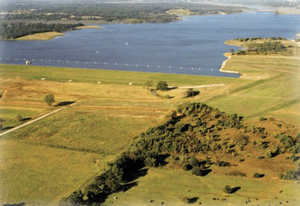Record Earthquakes Leave Dams Undamaged

After a four-day period, Nov. 5-8, 2011, when a series of earthquakes shook Oklahoma, including the largest in state history, the Oklahoma Conservation Commission reports that the state’s small watershed flood control dams showed no significant visible damage.
The earthquakes centered around 35.55N latitude and 96.76W longitude in northwest Lincoln County, or about 8 miles southeast of Perkins. A 4.7-magnitude quake occurred at 2:12 a.m., followed by lesser tremors during the day, capped by the record-breaking 5.6-magnitude quake at 10:53 p.m. The 5.6 earthquake broke the state’s previous record for strongest recorded earthquake — a 5.5-magnitude quake in El Reno in 1952, according to the Oklahoma Geological Survey and the U.S. Geological Survey. Another earthquake, registered at 4.8-magnitude, was centered slightly to the southwest on Nov. 7.
Within 48 hours after the 5.6-magnitude quake, a cursory inspection by local conservation districts determined that no visible damage had occurred to the high hazard structures within the area closest to the heart of the quake. Over the course of the next 48 hours, additional inspections were conducted on other structures to determine if the earthquake had any negative impact on them.
“With over 36 high hazard dams within 50 miles of the epicenter of the quake that hit Saturday, Nov. 5., and a reduced staff due to tight budgets, it took us some time to evaluate the system, but reports indicated that the structures came through the tremors without significant visible damage” said Mike Thralls, Executive Director of the Oklahoma Conservation Commission.
According to Clay Pope, Executive Director of the Oklahoma Association of Conservation Districts (OACD), this recent event again shows the importance of adequately funding conservation in Oklahoma.
“With the tight budgets we have been facing at the state, local and federal levels these last few years, we are struggling to make sure we have the staff and funding necessary to maintain the integrity of our flood control system,” Pope said. “Luckily we seem to have suffered no significant damage due to these last earthquakes. This event shows however, that it is extremely important that we keep the system of conservation districts and the staffing at the Conservation Commission funded at the level sufficient to maintain and operate these structures because you never know what kind of challenge will come next. It might even be a record earthquake in Oklahoma.”
“Assistance from the Oklahoma Conservation Commission is available to conservation districts and municipalities who feel the need to video inspect spillway pipes,” said Robert Toole, director of OCC’s Conservation Programs division. “OCC has a robotic camera and an experienced team who can perform this type of inspection,” Toole said.
